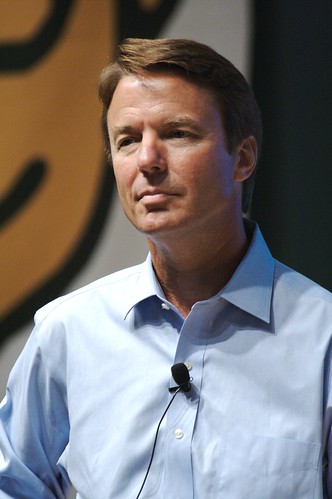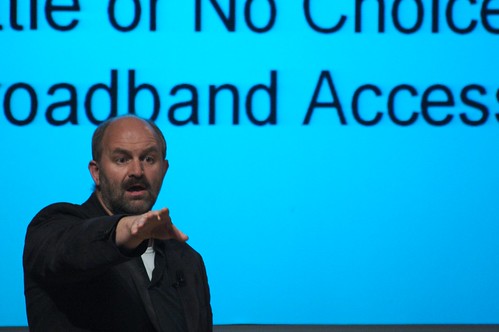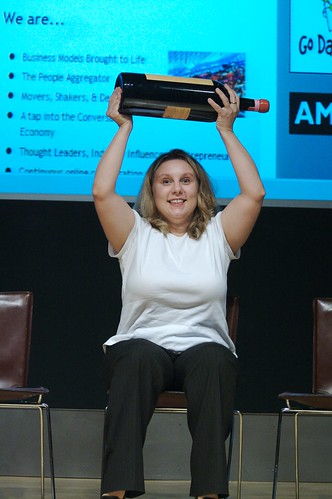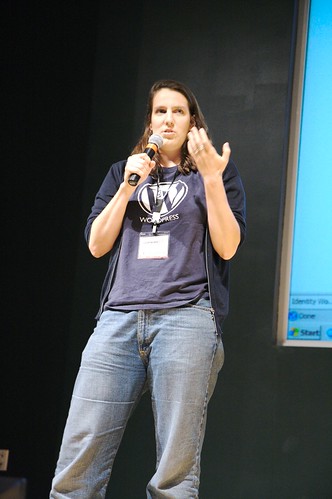Ted Leung on the air: Open Source, Java, Python, and ...
This year Chris and Ponzi asked me to shoot some pictures during Gnomedex 6.0, so I spent a lot of Gnomedex running around with a camera in my hand. This post is the usual roundup of impressions of the conference. I'm going to write a second post about the photography experience.
The appearance of John Edwards was one of the big deals of the show, hitting the front page of the Seattle Post Intelligencer over the weekend.
Senator Edwards
Lots of people seemed focused on whether or not Edwards was "their" candidate or not, and on whether or not he got it. Edwards got lots of props for admitting that it was very hard for him (and other politicians) to break out of the guarded facade that has been the standard for politicians for many years. I think that the public also has to break out of its old way of relating to and viewing politicians. Before Edwards arrived, Chris Pirillo pled with the audience to use this as an appearance as an opportunity to help Edwards learn about "us", the technology world and so forth. I was struck by how a conference full of bloggers slipped right into treating Edwards as a political expert and peppering him with questions about his positions. Since I was shooting the show for Chris, I got the chance to be in the green room with Chris, Ponzi, and Edwards both before and after Edwards went on stage. Afterwards, Chris was apologizing to Edwards because the discussion ended up being much more political and less of the educating that Chris was hoping for. Edwards turned to Chris and said "You know, you just can't stop them from asking the political questions". It seems that the public is as programmed as the politicians. Somehow we need a way to break the cycle.
Amazon CTO Werner Vogels
I found Werner Vogel's session on Network Neutrality to be very informative. It was personally useful to me to get a good summarization and overview of the state of the debate. He cited the Wikipedia entry as a good reference for those interested in tunneling deeper.
Bloglines gave Big Wine for Big Ideas
The juxtaposition of the Bloglines Big Ideas session with Steve Gillmor's Attention session was quite amusing. The winner of the Blog Ideas session was the idea that an aggregator should figure out what you are interested and help filter out the stuff that you aren't. I'd call that an attention+reputation based aggregator, but that's just me. Gillmor announced the "Attention Operating System" - the product of a venture between GestureBank and root.net. This is something I'm going to be keeping my eye on.
An interesting thing that Dave Winer said during his session was something to the effect that manufacturing companies are going to be come outsourced services to make stuff for people that have ideas. I think that this meshes very well with the themes that Eric von Hippel has been writing about in Democratizing Innovation
Kaliya Hamlin, Identity Woman
Kaliya Hamlin (Identity Woman) did a great impromptu session on the gap between the civil society (users) and the social tool building sector (developers). One of the efforts that she mentioned was the Interra project. Kaliya's profile has been rising recently and with good reason. It was good to see Dave Winer and Marc Canter vocally supporting her as the discussion leader. Gnomedex MVP indeed.
There was a much publicized confrontation between Dave Winer and Blake Ross, which seems to be on its way to a resolution. I'm happy that there was a resolution, but as I watched the incident there was one thing which really surprised me. Both Dave and Steve Gillmor chastised Blake (and the Firefox project) for being non-transparent, particularly with respect to product plans. The thing that surprised me is that both Dave and Steve are very savvy, and yet they seemed unaware that the product plans for Firefox are up on a public wiki, that the development is coordinated via public newsgroups and so forth. If people like Dave and Steve think that product plan information is secret the way that it is in proprietary software companies, then we in the open source community as a whole need to really rethink how we are communicating with users.
Chris did a session with some VC's where he pitched them on TagJag in front of all of Gnomedex. I though that this was a pretty educational session for people interested in getting a project funded. Jeff Clavier has more on what happened.
In addition to the zillion posts in the blogosphere, you can also see the notes that the indJet folks were taking with Mind Manager. So far only the day 1 notes are up.
This the first conference that I've attended using the official unconference format (Gnomedex used the regular speaker format last year). Werner Vogels wrote:
Beyond this the conferences that focus on participation are best served by the Open Space approach. I don’t think the “unconference” hybrid model is as effective as Open Space. Unconferences still rely on big names and predefined topics to restrict the conversation. In Open Space all the participants come together on the first day to define the topics to be discussed and anyone can propose a topic within the theme of the conference. Participants then go to take part in the discussions they are most passionate about. There is some additional structure around the process to make sure everyone learns about the details of every topic that was discussed. The outcome depends a lot on the theme or the goals of the conference, but in general I have found that the participants feel extremely empowered by this approach.
The goal of Open Space is to make the whole conference one long coffee break …
I definitely agree with this, and Ethan Kaplan made note of the asymmetrical nature of the format during his session (I wasn't wowed by Ethan's session, but there's a lot of good stuff in his Gnomedex wrapup). For me it was still the case that the very best parts of Gnomedex were single person or small group interactions that I had with people during the parties or in the hallways.
One of those great conversations was with Philip Pearson, whose blog I've been reading for years, and who is now working on Marc Canter's People Aggregator. Philip just put up a post discussing the details of the People Aggregator API.

You might peruse wedding photography books/sites - they're faced with some of the similar issues in events.
I'm not sure what the best way to deal with the problem of looking up at the podium - not the best angle on many people for sure! Maybe move further back with a longer lens would help.
Lighting looked pretty good - surprisingly good for available light. Maybe softer on some of the on-camera flash shots. Heavy bounce and a diffusor works well for that.
I was surprised to see "manual" mode on a few of those shots.
For improving workflow: I would consider shooting JPEG directly. If you're shooting with flash, or have the opportunity to white-balance, and aren't going bigger than 8x10, RAW just adds time.
Those are a lot of caveats I realize, but a quick curve adjustment and crop is usually all I need to do with JPEG's.
Posted by Rick at Wed Jul 5 17:34:39 2006
Posted by Brandon Watts at Wed Jul 12 11:18:36 2006
I think "3 hour sessions" is good, too: It really gives you time to get into things with a group of other people.
It allows for a lot more space between sessions, too, since most sessions don't take all 3 hours.
It doesn't feel nearly as rushed, either.
1-hour unconference sessions are races. I really feel the overhead of scheduling, and that 15 minutes to switch rooms (included in the session hour) is felt as well: It's fully 25% of the session time!
Posted by Lion Kimbro at Thu Jul 13 01:15:26 2006
 Add a comment here:
You can use some HTML tags in the comment text:
Add a comment here:
You can use some HTML tags in the comment text:To insert a URI, just type it -- no need to write an anchor tag.
Allowable html tags are:
<a href>, <em>, <i>, <b>, <blockquote>, <br/>, <p>, <code>, <pre>, <cite>, <sub> and <sup>.You can also use some Wiki style:
URI => [uri title]
<em> => _emphasized text_
<b> => *bold text*
Ordered list => consecutive lines starting spaces and an asterisk












